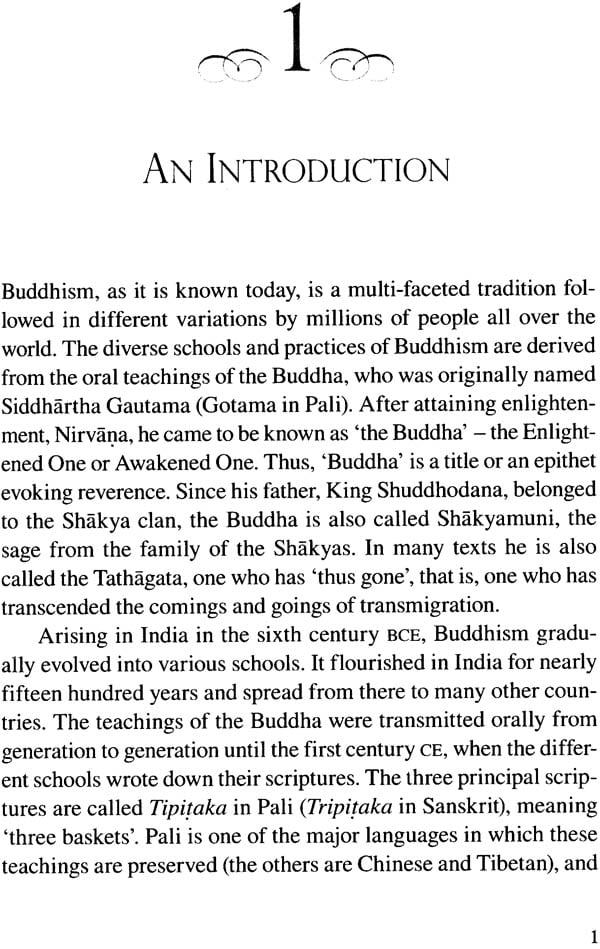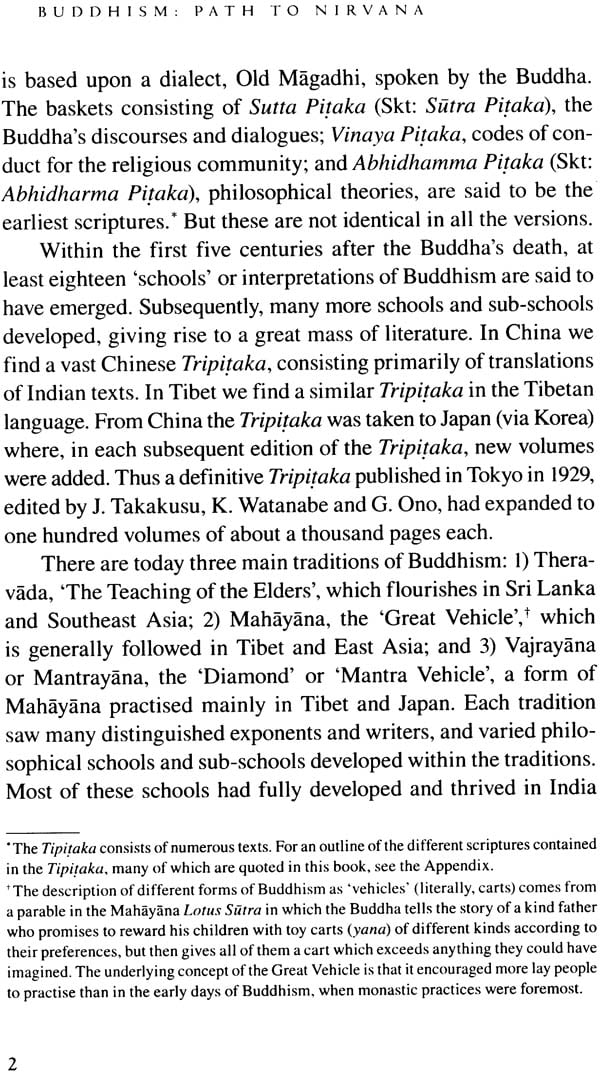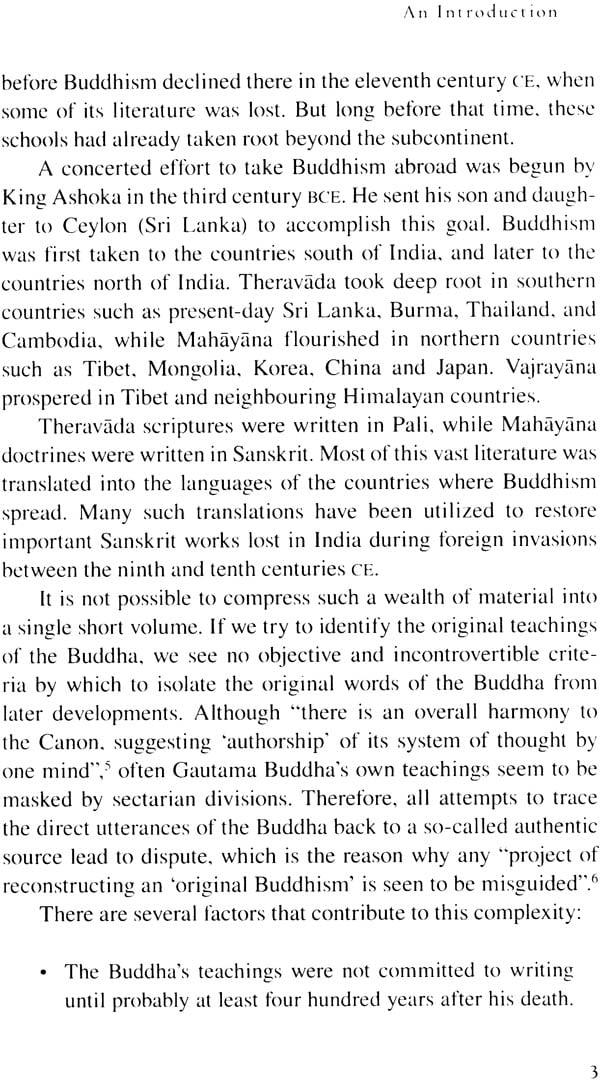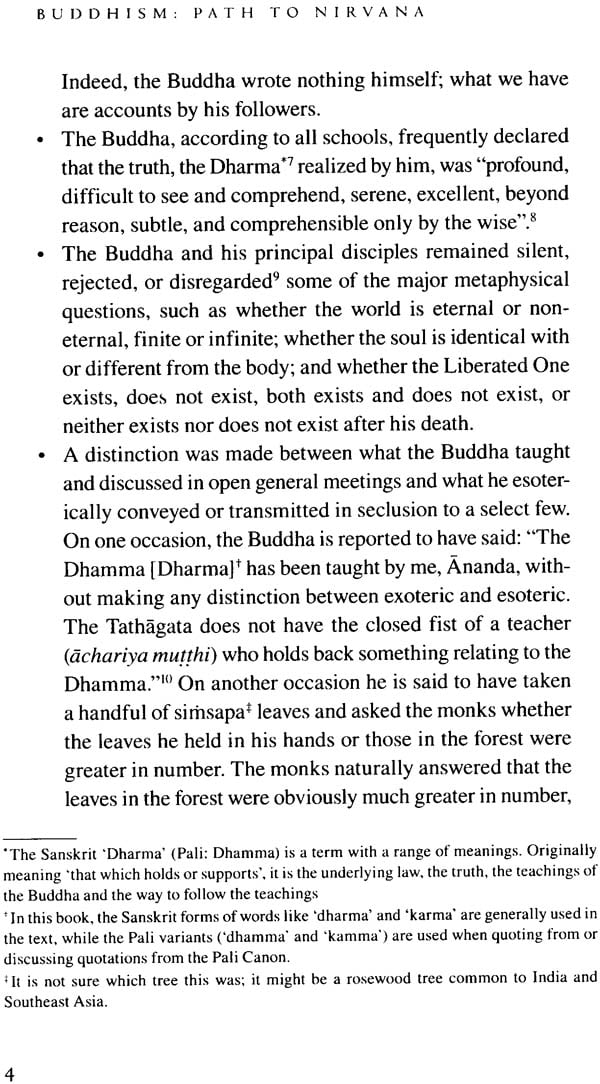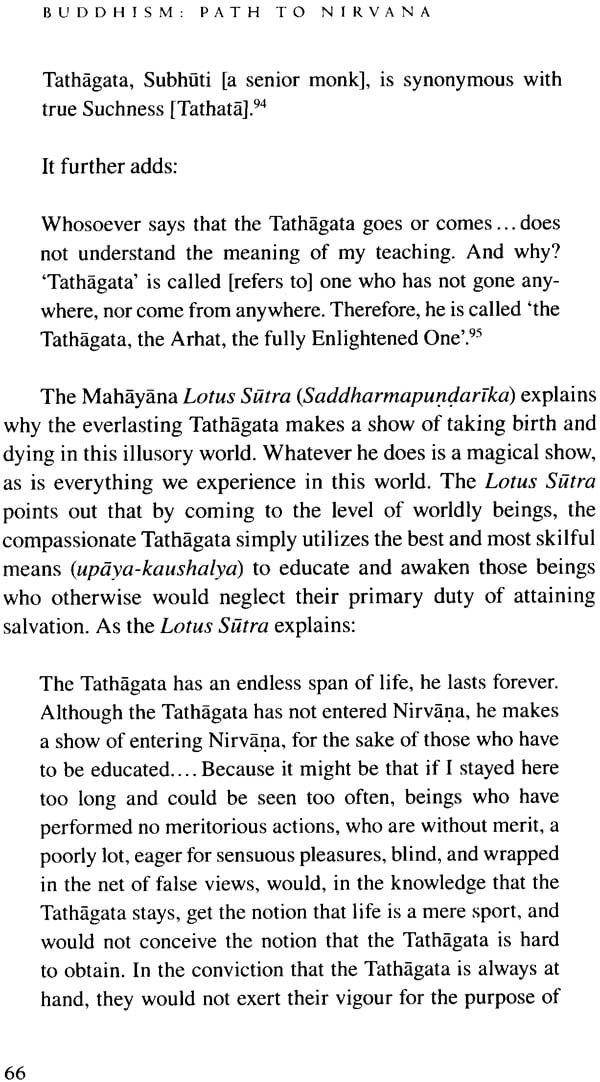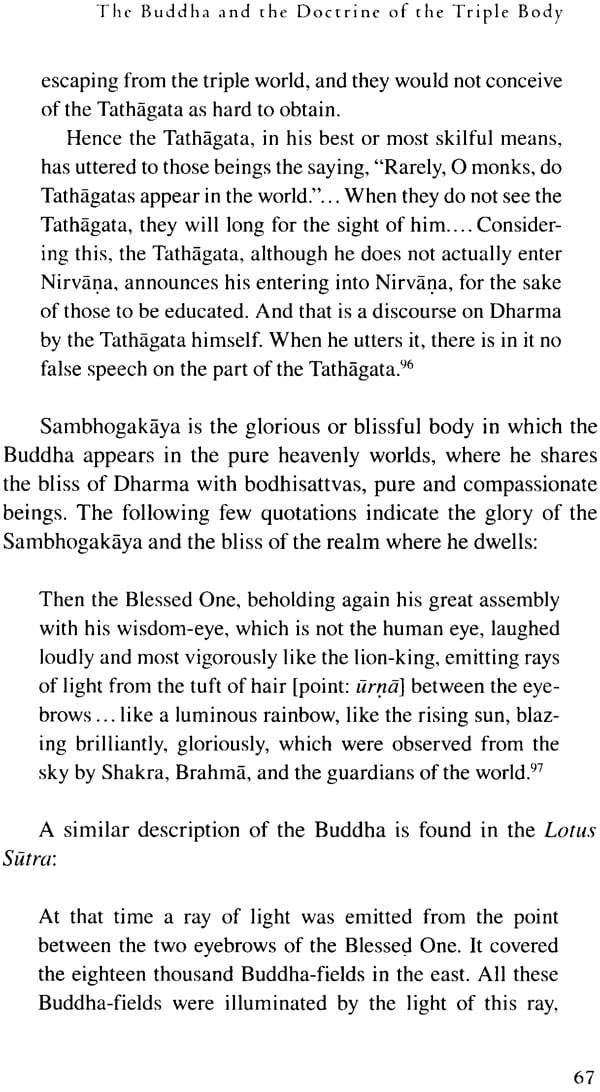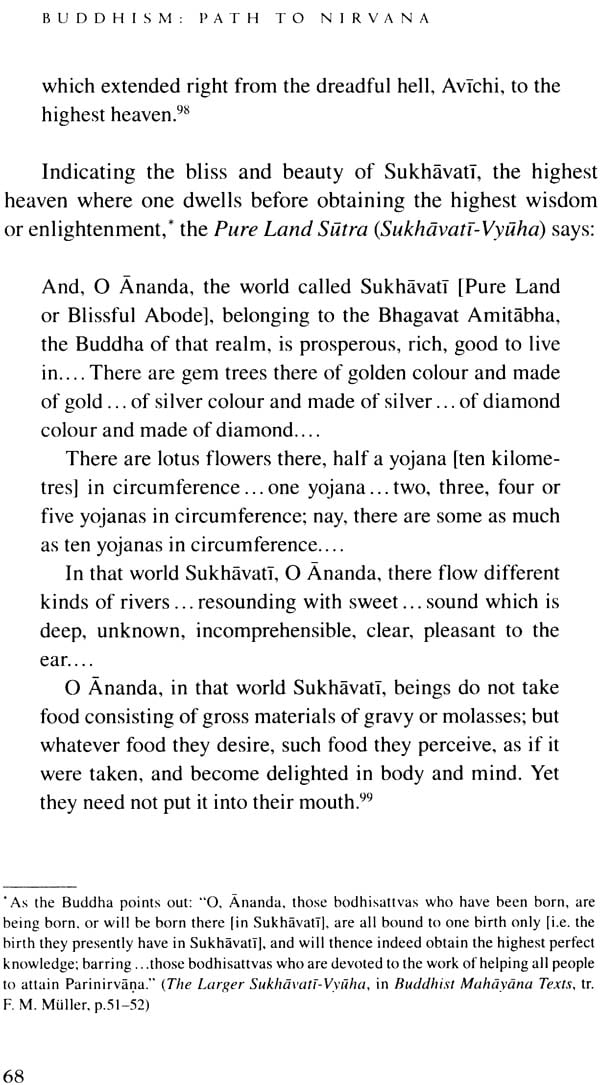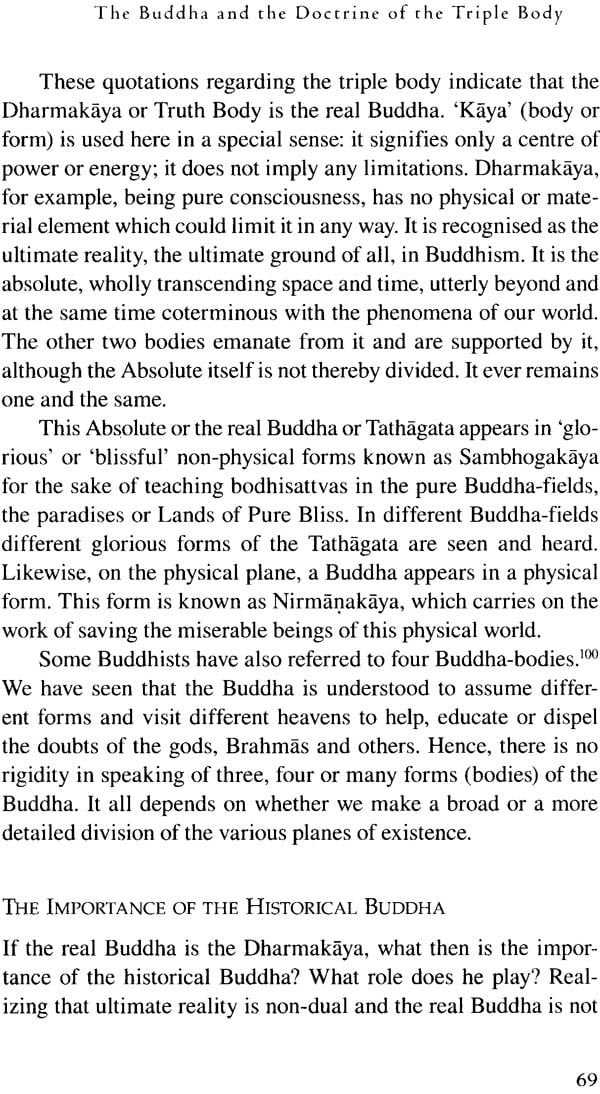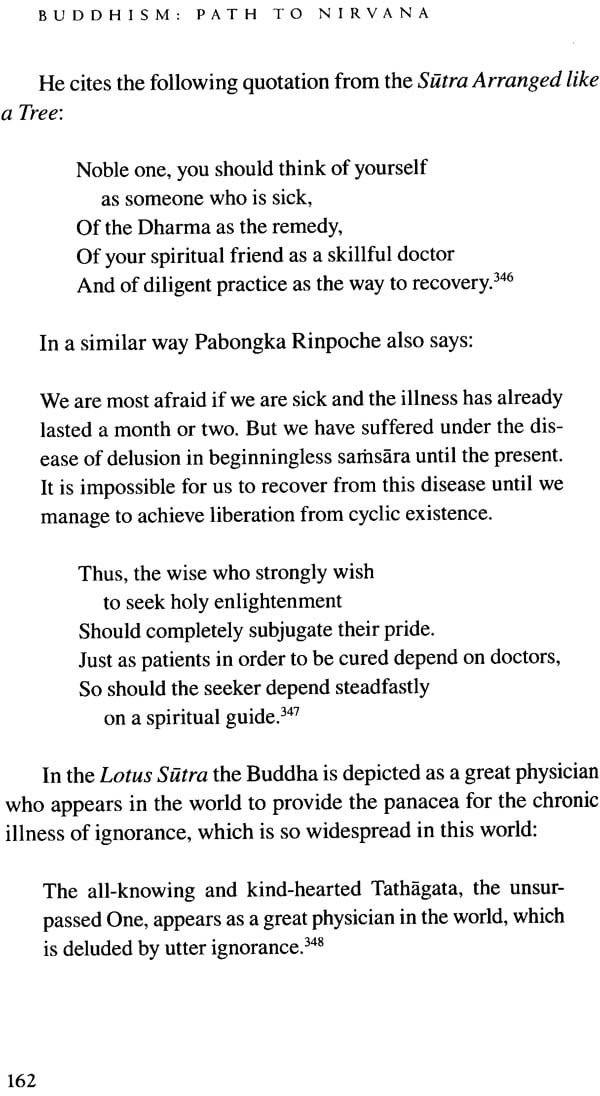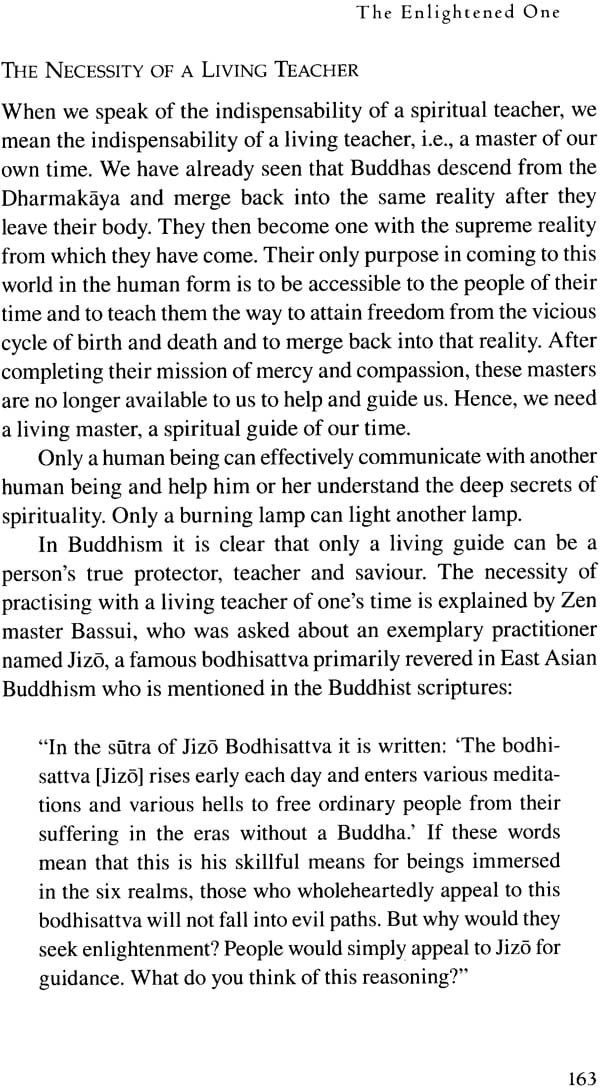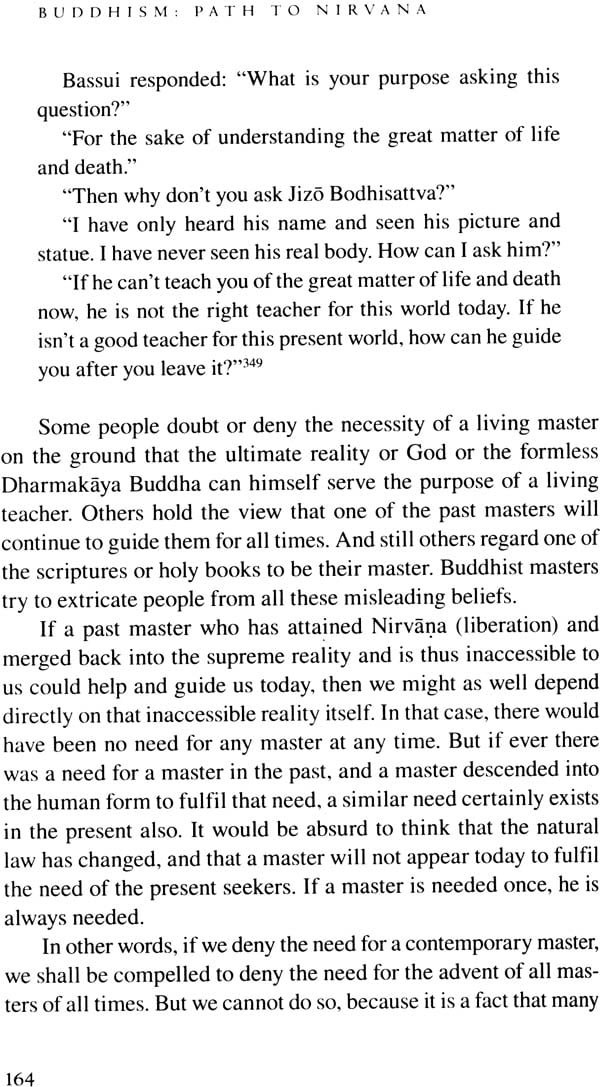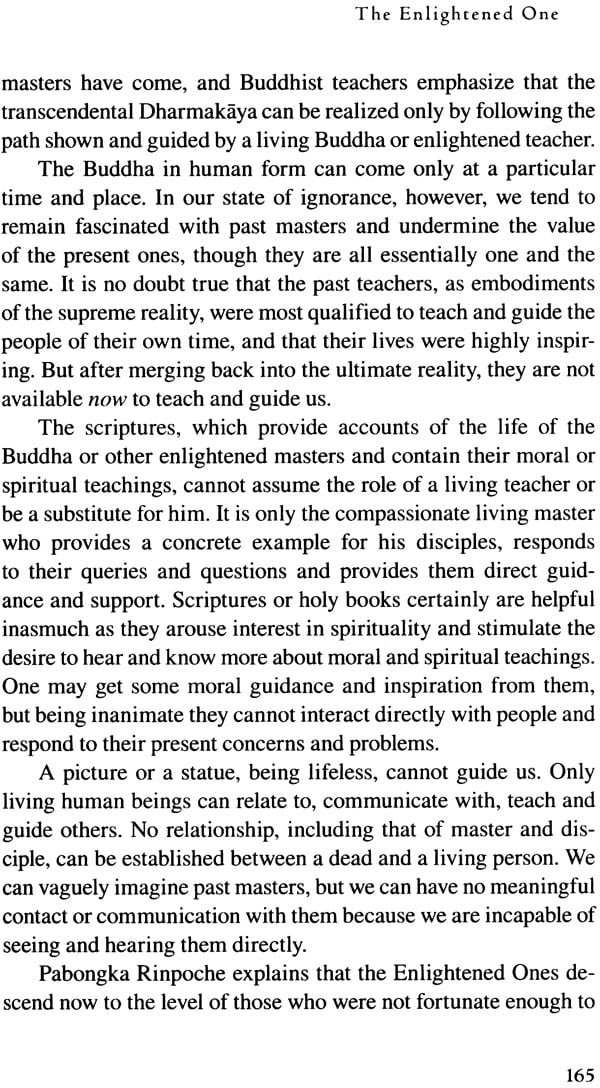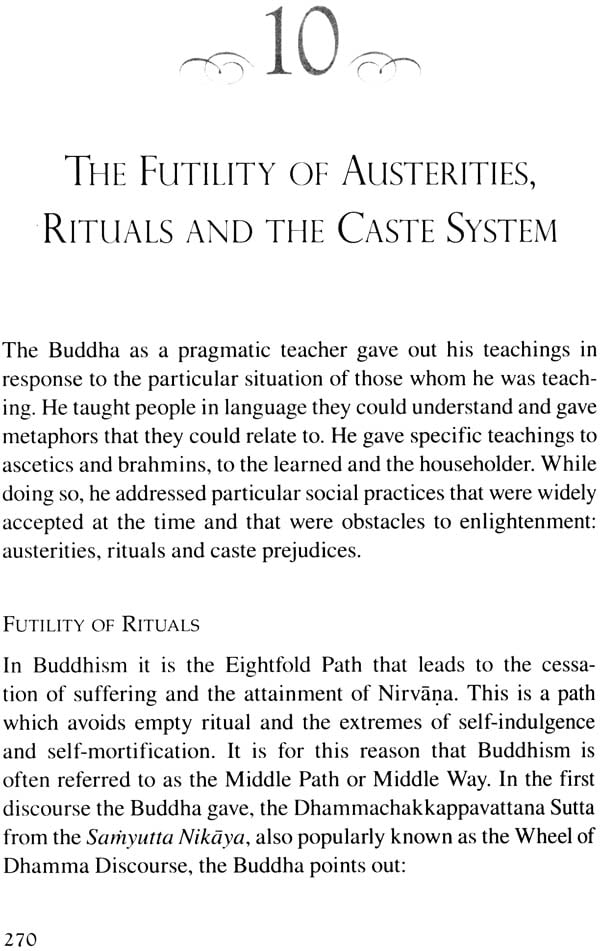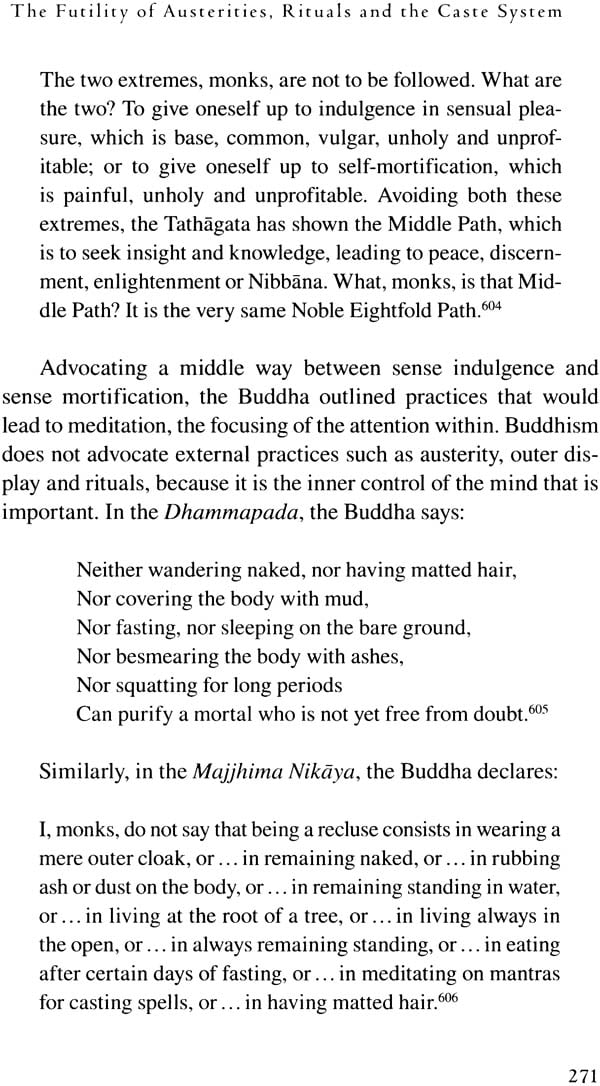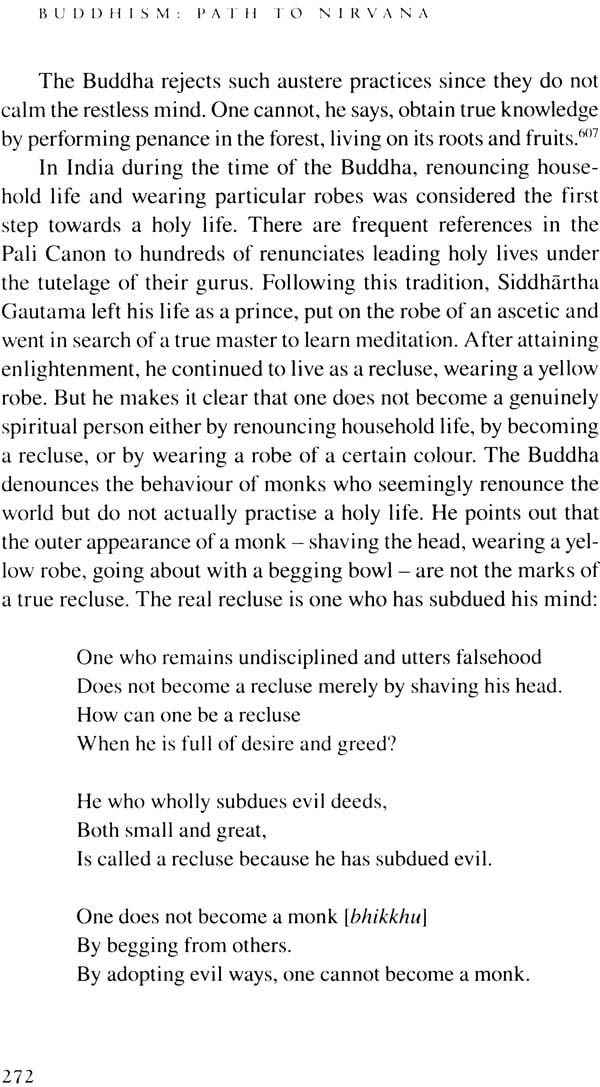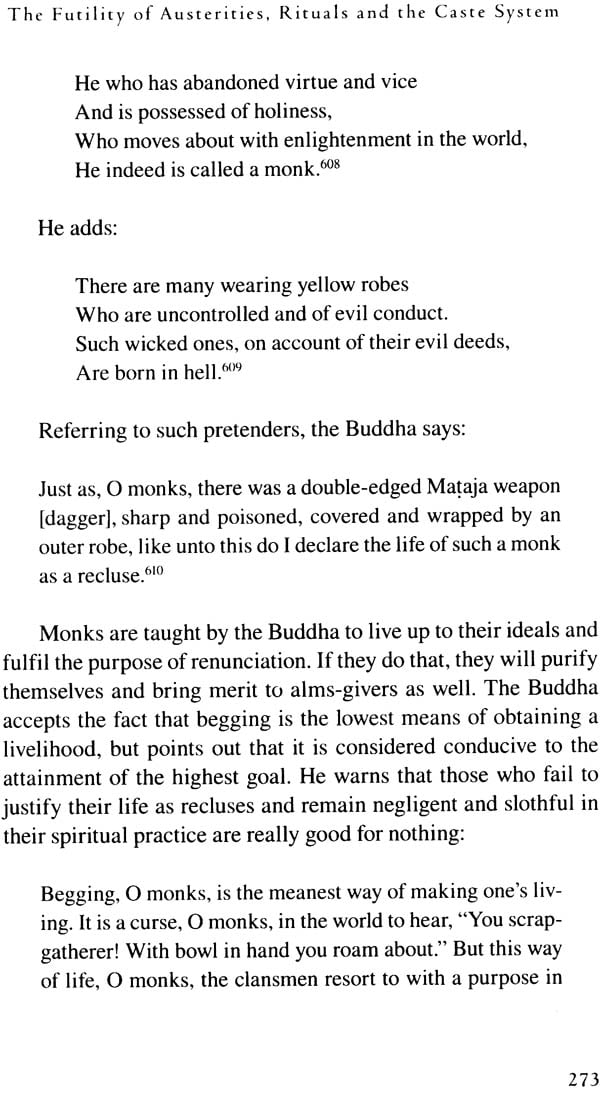
Buddhism: Path to Nirvana
Book Specification
| Item Code: | NAC660 |
| Author: | K.N. Upadhyaya |
| Publisher: | Radha Soami Satsang Beas |
| Language: | English |
| Edition: | 2010 |
| ISBN: | 9788184663198 |
| Pages: | 405 |
| Cover: | Hardcover |
| Other Details | 8.8 Inch X 5.8 Inch |
| Weight | 630 gm |
Book Description
Better than offering thousands of sacrifices, Month after month for a hundred years, Is one moment spent honouring one, Who has perfected himself.
Better than the life of a hundred years, Spend without perceiving the excellent Truth, Is a single day spent, Perceiving the sublime Dharma.
Refraining from all evil, Cultivating what is good, And purifying one’s mind, This is the teaching of the Buddhas.
Buddhism: Path to Nirvana explores the teachings of Buddhism from the perspective of a perennial philosophy that links all yearning for truth through a common foundation. The author, Professor K. N. Upadhyaya, has studied the ancient languages of Sanskrit and Pali and his field of specialization has been the philosophies of India. He has also been associated for many years with a lineage of adept teachers of surat shabd yoga (the yoga of uniting the soul with the sound current). For this book, he has brought his scholarship and personal understanding of the philosophy of the eternal way to his exploration of Buddhism and the earliest Buddhist texts in their original.
If we look to the heart of any of the world’s great religions, we see how much they have in common. They all say that there is a beginningless beginning, a reality beyond time and matter. Thus, Truth remains eternal — the same for all groups and for all time. This supreme reality is also presented by every scripture and by every account of the personal quest for understanding as ineffable and beyond the reach of words and mind.
The common message of Buddha and other spiritual giants is that enlightened teachers keep coming through the ages and their teachings are for everyone without distinction. All indicate one Truth for the whole world; all speak of life’s source as compassion, non-violence and love; and all say that this love is accessible and available to all. Buddhism, in common with other spiritual traditions, emphasizes the paramount need for regular spiritual practice, for making one’s best effort to gain insight into the reality beyond intellect and words and to experience this reality. It is the hope of the publishers that this book will contribute towards this understanding.
Among all living beings only human beings are endowed with the faculty of reasoning and discrimination. Therefore, we have a natural inclination, whether mild or strong, to know about our selves unravel the mystery of the world and realize the objective of human life. To do so, it is very helpful to know what the great sages, saints and Enlightened Ones, whether of the East or West, have said regarding these matters, especially regarding the ultimate Truth and the way to realize it.
Gautama, the Buddha, is certainly one of the greatest masters to ever appear in this world. He is widely known for his sincere quest for the truth, persistent endeavours, moral earnestness, spiritual insight and finally his compassionate resolve, after his enlightenment, to preach and propagate his teachings for the good and happiness of many.
The Buddha established his Dharma (teachings) more than two thousand five hundred years ago, but his thoughts and deeds are still alive and vibrant today in the minds and hearts of a multitude of his devoted followers. Many kingdoms and empires established by mighty kings and emperors on the strength of brutal force, arms and ammunition proved short-lived when com pare to the long life of the Dharma established by the Buddha on the foundation of his love and compassion and his heart-felt desire to do ultimate good to people. Kings and emperors live to increase the power, wealth and importance of their own selves, whereas sages and the Enlightened Ones efface their self and live for others. The former appear and, after glittering for a while, disappear into oblivion, whereas the latter appear to show the way to immortality to a multitude of people lost in ignorance and misery.
The Buddha is not to be looked upon as an ordinary individual who quietly fades out from this world. All Buddhas are wise and compassionate luminaries who have been coming to this world in succession since time immemorial and will continue to do so for all times to come. Gautama, the Buddha, himself refers to the previous Buddhas2 and speaks of himself as one who has known and seen the Truth and the way to it, as others had known and seen in the past.3 The teaching of one who has attained enlightenment or Buddhahood, a universal or immortal state, is called Buddhism. Thus, it signifies a universal teaching having a universal appeal.
It may be a commendable venture to undertake the study of the huge growth of Buddhism in all its phases and with all its glory and grandeur. But, for the purpose of this short book, we shall try to bring out the essence and spirit of Buddhism from the vast literature of many of its schools and make a clear presentation of its central moral and spiritual teachings. Buddhism points out that to attain enlightenment or the deepest insight is the ultimate goal of human beings. For this it lays emphasis on leading a good moral life, on being steadfast in one’s meditation under the guidance of a competent living master and on making one’s best effort to gain insight into the realm beyond intellect and speech. This indeed is the core of the common human heritage of wisdom emphasized by many renowned sages and saints all over the world.
We know that the Buddha had an intensely practical outlook. He avoided answering metaphysical questions. He felt that any answer given would be intellectually incomprehensible and of little practical use to the questioner with only limited understanding. He therefore drew attention to the universal problem of ignorance and suffering, and showed the way to enlightenment and freedom from all suffering. In preparing this book, this practical approach of the Buddha has been duly borne in mind.
The presentation of this book is based mainly on original texts of Buddhism. Materials from the vast literature of Buddhism which are directly linked to or implied by the early Buddhist texts, particularly the early stratum of the Pali Canon, have been duly utilized. The base of early Buddhism has been supported and supplemented by later Buddhist texts and treatises. Quotations from the original Pali and Sanskrit texts generally follow the standard English translations listed in the bibliography. At times the translations have been modified for clarity or to make the translations closer to the author’s understanding of the original language. This book has made use of a few diacritical marks, as listed in the beginning of the book, mainly for Pali and Sanskrit words. A glossary has been provided, which includes entries for the authors and books most quoted.
In our modern hi-tech society, the living tradition of spiritual knowledge and practice is being increasingly marginalized. Yet there may still be some people willing to lend their ears to the time-tested teachings of the Buddha and tread the path prescribed by him.
It is precisely with this thought that the Buddha resolved to preach:
Among being there are some
With just a little dust in their eyes.
Not hearing the truth, they are languishing;
If taught, they will see the truth.
| Pronunciation Key | xi | |
| Foreword | xiii | |
| Author’s Note | xv | |
| One – An Introduction | 1 | |
| Two – The Life of the Buddha: A Teaching Story | 11 | |
| Three – The Buddha and the Doctrine of the Triple Body | 61 | |
| Three Dimensions of the Buddha | 62 | |
| The Importance of the Historical Buddha | 69 | |
| Down to Earth | 73 | |
| Four – Human Life | 75 | |
| Human Life Is Difficult to Obtain | 75 | |
| All Is Within the Human Body | 79 | |
| Human Life is Impermanent and Perishable | 82 | |
| Human Life Fulfilled | 85 | |
| Human Life Wasted | 90 | |
| Five – A World of Impermanence | 95 | |
| Three Marks of the Phenomenal World | 95 | |
| Impermanence | 96 | |
| Suffering | 99 | |
| Non-Self | 103 | |
| Six – A Perspective on Buddhist Views on Soul and God | 110 | |
| The Buddhist Perspective on Soul | 110 | |
| The Five Constituents of Personality | 112/td> | |
| Differentiating the Soul (atma or atman) from the Personal Self (atta) | 113 | |
| Soul as Jiva | 118 | |
| Soul and Nirvana | 120 | |
| The Buddhist Perspective on God | 123 | |
| Buddhism and the Contemporaneous Literature on God | 124 | |
| The Law of Cause and Effect | 130 | |
| Ultimate Reality and Brahman | 134 | |
| Is There a Personal God? | 141 | |
| Seven – The Enlightened One | 145 | |
| The Buddhist Perspective | 147 | |
| Taking Refuge in the Buddha | 155 | |
| The Indispensability of a Teacher | 156 | |
| The Necessity of a Living Teacher | 163 | |
| Masters Are Always Present in the World | 167 | |
| The Unbroken Chain of Living Teachers | 169 | |
| The Teacher’s Responsibility | 174 | |
| The Disciple’ Attitude | 177 | |
| The Disciple’ Duty | 182 | |
| Discrimination in Finding a Fully Enlightened Master | 191 | |
| Faith and Devotion | 199 | |
| Eight – The Eternal Path: Perspectives and Practices | 211 | |
| The Three Jewels | 212 | |
| Bodhichitta | 217 | |
| The Essential Practice of the Eightfold Path | 218 | |
| The Five Essential Precepts or Abstentions | 221 | |
| Reverence for Life and Vegetarianism | 225 | |
| Control of the Mind | 232 | |
| Detachment | 235 | |
| The Meditation Practice – Dying While Living | 237 | |
| Nine – Inner Experiences of Sound and Light | 247 | |
| All is Sound and Light | 248 | |
| The Buddha’s Enlightenment: An Experience of Light and Sound | 251 | |
| The Transcendent Voice of the Buddha | 253 | |
| Experiencing the Transcendent form of the Buddha | 256 | |
| Experiencing Light and Sound in Meditation Practice | 256 | |
| Ten – The Futility of Austerities, Rituals and the Caste System | 258 | |
| Futility of Rituals | 270 | |
| Futility of Caste Distinctions | 270 | |
| Conclusion | 279 | |
| Appendix: Texts Included in the Pali Canon (Tipitaka) | 285 | |
| Endnotes | 289 | |
| Key to Abbreviations of Texts Quoted | 291 | |
| Glossary | 291 | |
| Bibliography | 205 | |
| Index | 249 | |
| Addresses for Information and Books | 373 | |
| Books on this Science | 389 | |
| Address for information and Books | 3929 |
